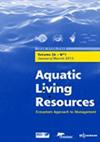凡纳滨对虾饲料中粉虫替代鱼粉:对生长性能、血清生化和免疫反应的影响
IF 1.9
4区 农林科学
Q3 FISHERIES
引用次数: 0
摘要
减少虾饲料中鱼粉(FM)的使用意味着全球鱼粉消费量的显著节省,从而降低生产成本和环境影响。昆虫粕是水产饲料中替代鱼粉的蛋白质来源之一。为此,本试验旨在探讨粉虫(MW, tenbrio molitor)替代粉虫对凡纳滨对虾(Litopenaeus vannamei)生长性能、血淋巴生化反应和先天免疫的影响。平均体重为7.41±0.13克的对虾在300升玻璃纤维池中(有用排水量为200升)养殖,密度为20只/池,为期60天。饮食处理,包括对照处理(无粉虫;采用随机设计,研究粉虫(MW)替代FM的T0、15% (T15)、30% (T30)、60% (T60)和100% (T100)水平,每组3个重复。本研究结果表明,各处理间肉鸡增重(BWG)、饲料效率(FE)、饲料系数(FCR)和肝胰脏指数(HPI)均有显著差异(P <;0.05)。随着FM置换量的增加至30%,BWG、FE和HPI均呈先升高后降低的趋势。胆固醇(Chol)、甘油三酯(Tg)和葡萄糖(Glu)水平随豆粕替代量的增加呈下降趋势,在高替代量时与对照组差异显著(P <;0.05)。此外,结果表明,与对照组相比,用MW替代鱼粉对实际饲料中超氧化酶歧化酶(SOD)、酚氧化酶(PO)、溶菌酶(LZM)、酸性磷酸酶(ACP)、碱性磷酸酶(ALP)活性和血细胞总数(THC)均有显著影响(P <;0.05)。总的来说,研究结果表明,MW是一种有希望的替代蛋白质来源,因为它可以提高生长性能和免疫系统。该研究建议在水产养殖业养殖物种的饲料中使用MW,因为它对生长性能没有不利影响,并且有可能减少其生产造成的环境后果。研究结果还强调了探索替代蛋白质来源以减少对鱼粉的依赖和提高水产养殖业可持续性的重要性。本文章由计算机程序翻译,如有差异,请以英文原文为准。
Fishmeal replacement by mealworm (Tenebrio molitor) in diet of farmed Pacific white shrimp (Litopenaeus vannamei): effects on growth performance, serum biochemistry, and immune response
Reducing the use of fishmeal (FM) in shrimp feed means significant savings in the amount of FM consumed globally and subsequently reducing production costs and environmental impacts. Insect meal (IM) is one of the protein sources to replace FM in aquafeeds. In this regard, this study was conducted with the aim of investigating the effect of replacing FM with mealworm (MW, Tenebrio molitor) on the growth performance, haemolymph biochemical responses, and innate immunity of Litopenaeus vannamei. Shrimps with a mean weight of 7.41 ± 0.13 gram were cultured in 300-liter fiberglass tanks (with a useful drainage volume of 200 liters) with a density of 20 shrimp per tank over a period of 60 days. Dietary treatments, including the control treatment (no mealworm; T0), 15% (T15), 30% (T30), 60% (T60), and 100% (T100) level of replacing FM with mealworm (MW), each with three replications, were investigated in the form of a randomized design. The results of this study showed a significant difference in body weight gain (BWG), feed efficiency (FE), feed conversion ratio (FCR), and hepatopancreas index (HPI) among the treatments (P < 0.05). With the increase of the replacement of FM with MW up to 30%, BWG, FE, and HPI were significantly increased then reduced. The levels of cholesterol (Chol), triglycerides (Tg), and glucose (Glu) showed a decreasing trend with increasing replacement of FM with MW and revealed a significant difference with the control treatment at high levels of replacement (P < 0.05). Besides, the results showed that replacing FM with MW had a significant effect on the activities of superoxidase dismutase (SOD), phenol oxidase (PO), lysozyme (LZM), acid phosphatase (ACP), alkaline phosphatase (ALP) and the total count of hemocytes (THC) in the practical diets compared to the control group (P < 0.05). Overall, the findings suggest that MW is a promising alternative protein source for L. vannamei, as it enhances both growth performance and the immune system. The study recommends the use of MW in the diet of farmed species in the aquaculture industry, given its lack of adverse impacts on growth performance and its potential to reduce environmental consequences resulting from its production. The results also underscore the importance of exploring alternative protein sources to reduce dependence on FM and enhance sustainability in the aquaculture industry.
求助全文
通过发布文献求助,成功后即可免费获取论文全文。
去求助
来源期刊

Aquatic Living Resources
农林科学-海洋与淡水生物学
CiteScore
2.30
自引率
0.00%
发文量
10
审稿时长
>24 weeks
期刊介绍:
Aquatic Living Resources publishes original research papers, review articles and propective notes dealing with all exploited (i.e. fished or farmed) living resources in marine, brackish and freshwater environments.
Priority is given to ecosystem-based approaches to the study of fishery and aquaculture social-ecological systems, including biological, ecological, economic and social dimensions.
Research on the development of interdisciplinary methods and tools which can usefully support the design, implementation and evaluation of alternative management strategies for fisheries and/or aquaculture systems at different scales is particularly welcome by the journal. This includes the exploration of scenarios and strategies for the conservation of aquatic biodiversity and research relating to the development of integrated assessment approaches aimed at ensuring sustainable and high quality uses of aquatic living resources.
 求助内容:
求助内容: 应助结果提醒方式:
应助结果提醒方式:


